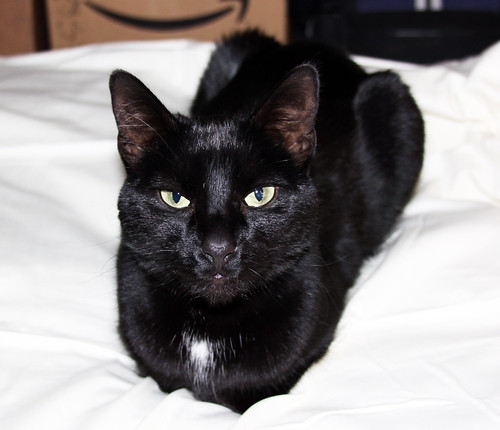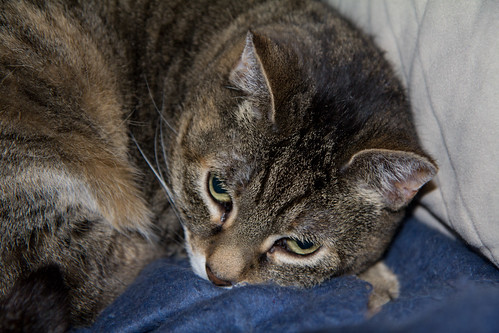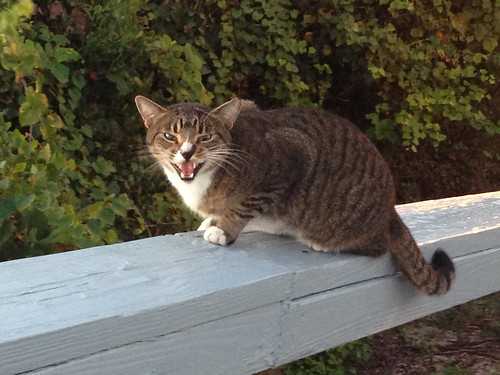 |
| Sasha was a stray cat who killed dozens of redpolls in my yard before we solved the problem by taking her in. |
Outdoor cats are the number one carrier of rabies among domestic animals. And every cat that feeds on, or even just toys with, rodents or birds can spread toxoplasmosis, which is exceptionally dangerous for pregnant women and their unborn babies and newborns, and also extremely dangerous for toddlers and the elderly. Outdoor cats tend to use flowerbeds and children’s sandboxes as their own personal litter boxes, putting gardeners and tiny children at risk. The St. Louis County Health Department’s testimony about these and other disease issues were enough to persuade the Duluth City Council to pass the leash law.
In the years since 2000, when the ordinance was enacted, we’ve learned even more about the risks of human diseases from outdoor cats. To quote a 2013 article in USA Today:
Approximately 300 rabid cats are reported each year in the United States, says Jesse Blanton, a CDC epidemiologist. The CDC estimates that 16% of people in the United States who undergo rabies treatment are exposed to the deadly virus from cats. They must be treated with a series of shots.People running trap-neuter-release programs say that the cats they release have been vaccinated, but this summer a vaccinated cat from a trap-neuter-release program in Florida attacked a person in Hillsborough County, and the cat tested positive for rabies. The victim had to undergo a painful series of rabies shots. (News report here.)
**Added 9/15: Frederick Minshall wrote me:
per the CDC the worst incidence of human rabies exposure in US history was caused by a TNR [trap-neuter-release feral cat] colony in Concord, NH in 1994. 665 people had to receive PEP [rabies shots]--at a cost of $2 million to the town. A rabid raccoon, attracted to the kibble left out by the idiot caretakers, infected four kittens (TNR kittens???), and THEN [the program] "adopted" (or sold) them to a local pet shop! They claimed they were "vetted", but of course being kittens they had no immunity and they all died.
Another in 2012 in Carlsbad, NM--this feral colony was courtesy of the imbeciles at "Animal Ark". 12 people got PEP, hundreds of pets and livestock destroyed--along with the cats themselves. **Cats are also the main vector for toxoplasmosis in humans—there is no vaccination for this, and cats that toy with or eat rodents and birds are the ones who carry this potentially deadly disease. One scientific paper published this month implicates toxoplasma in human epilepsy, neuro-degeneration and cancer.
Since 2000, we’ve also grown increasingly aware of the danger outdoor cats pose to wildlife populations, especially to birds. Outdoor cats are now known to be the worst outright killer of wild birds, and are known to have decimated and even extirpated whole populations of vulnerable bird species.
Domestic cats are natural killers. But they are not part of any natural food chain in America. On top of not being native to North America, people subsidize domestic cats with supplemental food, veterinary care, and shelter. Of all the predators in the world, only domestic cats can maintain high numbers in an area even after decimating and even extirpating natural prey.
Since Duluth’s cat leash ordinance was passed, we’ve also grown increasingly aware of the importance of Duluth, Minnesota, as a migratory passageway for birds. We’ve had 17 years more data collection at Hawk Ridge, and our current counters have been keeping track of our songbird migration, too. The species composition of the flood of migrants through here includes some abundant species, such as geese and robins, but also many, many declining and even endangered species, such as Piping Plovers, Bobolinks, and Eastern Meadowlarks.
The migration doesn't start and end in Duluth, of course. These birds are funneling down the shore in a wide swath. All of northeastern Minnesota is host to exceptional numbers of migrants in spring and fall, and large numbers of birds breed up here, too, vulnerable to cats (especially their young) from spring through fall. Many winter finches up here are drawn to road salt, and I've seen cats lurking in ditches in winter waiting for just such an opportunity.
Now Duluth's own Animal Allies is promoting an “Adopt a Barn Cat” project, in which people can bring home a barn cat for $25. (Right now their website is advertising a 2-for-1 sale!) They acknowledge that these cats are feral, stating, "these independent-minded felines are not suitable indoor companions."
They want people to keep the cats in a protected barn or shed for 2-4 weeks so they will get used to being fed there, but that’s just a suggestion, not a requirement; once the barn door is open, the cats can roam wherever they want.
I called Animal Allies on September 14 and asked if I could adopt one if I live in Duluth. The woman who answered the phone said sure, as long as I had a heated shed or garage. When I mentioned Duluth’s cat leash law, she was confused and asked me to call later in the morning when I could talk to one of the adoption staff. So I called later, and asked an adoption specialist if I could adopt a barn cat if I lived in Duluth. This person also said sure, as long as I had a heated garage or shed. Again I pointed out that Duluth has a cat leash law, and again she hadn’t considered that. She asked that I call back when the manager was there, but this was their day off.
My friend Lisa Johnson, an Animal Allies volunteer, called them on September 15 and reports on Facebook:
I touched base with Animal Allies Humane Society's operations director. Barn cats are not placed within city limits, and adopters are encouraged to keep companion cats indoors. Also, there will be additional instruction for the new work-study students learning the ropes and answering the phones.I'm glad to know they're not adopting them out right within Duluth city limits, but nevertheless, this misguided program puts human beings and many native species of birds and other animals in our area at risk. The fact that two people who answered the phone didn't seem very aware of Duluth's cat leash law, combined with their assurances to Lisa that people adopting companion cats are encouraged, not required, to keep those cats indoors seems very disturbing, too. The staff at Animal Allies needs to be more informed both about the existence of local ordinances and the important reasons those laws exist—reasons that are important outside city boundaries as well.
I also can't help but wonder how Animal Allies has enough unsocialized, admittedly feral cats to adopt out on a 2-for-1 sale, when they acknowledge that feral cats without heated outbuildings have a low chance of survival up here. I trust they're not actually bringing feral cats from other communities to our area. **Update: one employee who has added a comment to this post assures us that they don't bring cats from other communities to adopt out here.**
The top line of the Animal Allies webpage about the barn cat program reads, “Got mice? Adopt a Barn Cat!” Yet lower down on the exact same page there's an FAQ:
Will the cats eat birds and other wildlife on my property?
Cats are opportunistic feeders. Providing them with a steady food source will reduce the effect they have on traditional prey.Essentially they’re saying that if you want a cat to eat mice, get one of these, but if you don’t want the cat to kill mice, birds, and other traditional prey, don’t worry—it won’t.
I only wish well fed outdoor cats didn’t kill traditional prey. I don’t know how many farmers have bemoaned the tragic fact that they hardly ever hear Bobolinks or meadowlarks anymore, when their own well-fed barn cats were one significant factor in those species' declines.
Duluth's amazing migration exists because of our location at the very tip of Lake Superior. The internationally important migration corridor extends all the way to the top of the lake, and several miles inland. During cold weather events, most of us have experienced the heartbreak of a migration fallout in our area, when suddenly the ground is covered with Yellow-rumped and Palm Warblers flitting about. In recent falls during some of these events, warblers have been killed by the thousands in car collisions along Highway 61 and other roads. During one such event, lasting a couple of weeks in the fall of 1991, when I was walking my son to kindergarten each morning, we'd find dozens and even scores of dead warblers littering the sidewalks every day. But these ones hadn't died in unavoidable auto collisions. When I figured out which cat was doing the killing, I gathered an armload of dead warblers and piled them on the owner's porch with a note warning that if I ever saw their cat outdoors again, I’d bring it to the animal shelter.
That well-fed house cat was proof that a steady food source does not reduce the effect a cat can have on "traditional prey"—indeed, because that cat was well cared for, it was in top condition to keep killing even though it wasn’t even eating those poor birds. When well-fed cats strew carcasses about like a toddler’s discarded toys, how can anyone call them natural predators?
The problem of free-roaming cats matches the problem we once had with free-roaming dogs, for the same two reasons: they pose dangers to human beings and to wildlife. Cats are domestic animals, so it is up to humans to prevent and solve the problems they cause. In no case has any trap-neuter-release program caused a dent in local cat numbers, despite the misleading hype by feral cat advocates.
During my adult life, I’ve taken in 6 stray cats that had each been eating birds. I’ve given them the best life I could. I still have two. Kasey, about 12 years old, came from a trap-neuter-release program in Ohio, and was eating birds in my daughter’s yard. I enticed her into my car with food and drove 800 miles home with her. Fortunately, she loved the car ride, and so she’s the cat I brought along on my drives back and forth to Ithaca when I was working at Cornell. The other, Kitty, is at least 20 years old now (I took her in in 1998 as an adult), and has thrived indoors, too, though she hates riding in cars—when I was in Ithaca, she stayed home with Russ.
If it’s horrible to contemplate euthanizing a cat, why isn’t it equally horrible to contemplate each of the animals that each individual cat kills? When I was a wildlife rehabber, I held far too many birds as the light in their eyes ebbed out after a cat attack. And I’ve necropsied far too many birds killed by cats, examining the wounds beneath those feathers, the crushed bones and the grievous internal injuries, to imagine that they died quickly or without suffering.
If we look at outdoor cats as individuals, why don’t we look at birds and other cat victims as individuals? Does their suffering and death have no meaning? And when we look at vulnerable bird populations versus dangerously overpopulated cats, how can we consider outdoor cats anything but an ecological scourge?
Heartbreaking as euthanizing cats is, and vital as adoption programs are for saving individual cat lives, cats belong indoors. Those that cannot adapt to indoor life and cannot be prevented from killing birds must be dealt with in the way we once had to deal with stray dogs. This is heartbreaking, but it's the only responsible solution to this human-caused problem.
Animal Allies' Adopt a Barn Cat project exposes humans and pets to diseases, and kills orders of magnitude more birds and other living creatures than the number of individual cats adopted out. I used to support Animal Allies, but as long as they promote and continue this misguided program, they are not allies to the vast majority of animals in our community. "Adopt a Barn Cat" could fairly be called their "Adopt a Subsidized Killer."
I will not approve comments that are personal attacks or do not forward the debate in a polite way. Links to TNR studies that have been proven false will not be permitted.



